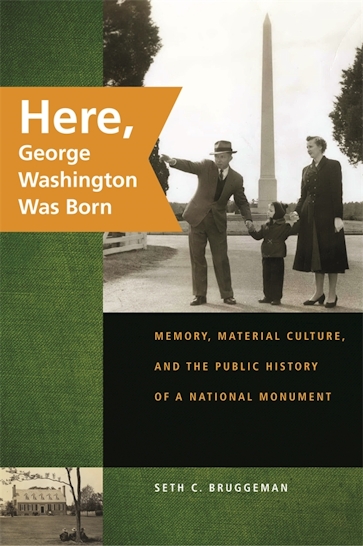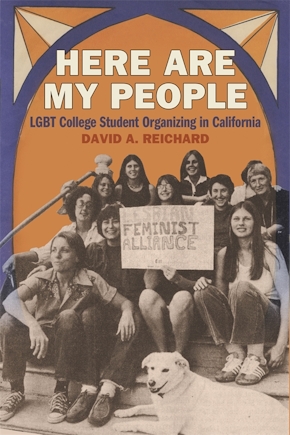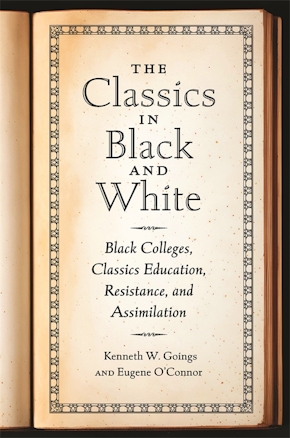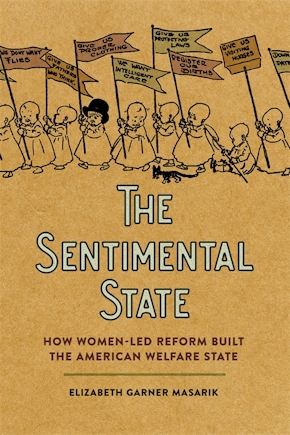Here, George Washington Was Born
Memory, Material Culture, and the Public History of a National Monument
Title Details
Pages: 272
Illustrations: 19 b&w photos
Trim size: 6.000in x 9.000in
Formats
Paperback
Pub Date: 11/15/2008
ISBN: 9-780-8203-3178-2
List Price: $30.95
Here, George Washington Was Born
Memory, Material Culture, and the Public History of a National Monument
Skip to
- Description
- Reviews
In Here, George Washington Was Born, Seth C. Bruggeman examines the history of commemoration in the United States by focusing on the George Washington Birthplace National Monument in Virginia's Northern Neck, where contests of public memory have unfolded with particular vigor for nearly eighty years.
Washington left the birthplace with his family at a young age and rarely returned. The house burned in 1779 and would likely have passed from memory but for George Washington Parke Custis, who erected a stone marker on the site in 1815, creating the first birthplace monument in America. Both Virginia and the U.S. War Department later commemorated the site, but neither matched the work of a Virginia ladies association that in 1923 resolved to build a replica of the home. The National Park Service permitted construction of the "replica house" until a shocking archeological discovery sparked protracted battles between the two organizations over the building's appearance, purpose, and claims to historical authenticity.
Bruggeman sifts through years of correspondence, superintendent logs, and other park records to reconstruct delicate negotiations of power among a host of often unexpected claimants on Washington's memory. By paying close attention to costumes, furnishings, and other material culture, he reveals the centrality of race and gender in the construction of Washington's public memory and reminds us that national parks have not always welcomed all Americans. What's more, Bruggeman offers the story of Washington's birthplace as a cautionary tale about the perils and possibilities of public history by asking why we care about famous birthplaces at all.
This innovative interdisciplinary study takes its place among a growing body of scholarship concerned with memory and commemoration, representation and authenticity, and heritage and tourism. Seth C. Bruggeman makes superb use of a kaleidoscopic array of sources to narrate a story of entanglement and ambivalence at George Washington's birthplace.
—Journal of Southern History
Bruggeman skillfully relates the story of Washington's birthplace to the growing literature on memory, commemoration, and public history. Here, George Washington Was Born is a very well informed, well researched, and effective case study that also serves as a broader introduction to cultural resource management.
—Theodore Karamanski, author of Rally 'Round the Flag: Chicago and the Civil War
In addition to his discussion of this national monument, Bruggeman provides a broader insight into the history of public commemoration from the Renaissance through the nineteenth century, highlighting the changing ways in which sites and objects have been revered. . . . Bruggeman’s study adds an important piece of the puzzle to our understanding of public history and the ways in which the past has been presented to general audiences during the last eighty years.
—American Historical Review
A valuable addition to the growing literature on how issues of public memory, commemoration, and authenticity play out at America's historic sites.
—H-FedHist
Despite what might seem at first glance a relatively minor topic—a history of the ill-fated and largely specious George Washington Birthplace National Monument in Virginia's Northern Neck—the author has done so much thoughtful work providing context (especially concerning the influence of the Colonial Revival and the evolution of National Park Service policies) that the book really is a 'must read' for many public historians. It is also a significant contribution to the flourishing field of memory studies.
—Michael Kammen, Public Historian
Professionals, especially those in interpretation and administration at historic and commemorative sites, will find much worthy of consideration in this book as they deal with both internal and external pressures at their sites. At the same time, this volume will be very beneficial to public history and historic preservation students as it provides a history of the preservation movement, a case study at a historic site, and demonstrates how public historians are often asked to deal with sometimes conflicting resources, missions, and agendas.
—History News
This fascinating book establishes a high standard for the cultural study of house museums and historic sites, and joins comparable works by Patricia West (1999), Eric Leepson (2001), and Scott Casper (2008) as highly desirable additions to any public historian’s bookshelf.
—Material Culture
Students of public history and the National Park Service will learn much from Bruggeman's in-depth exploration of the decades-long conflict between popular veneration and historical analysis at Washington's birthplace. A fascinating tale of the elusive quest for authenticity at a modern American tourist site.
—David Glassberg, author of Sense of History: The Place of the Past in American Life



